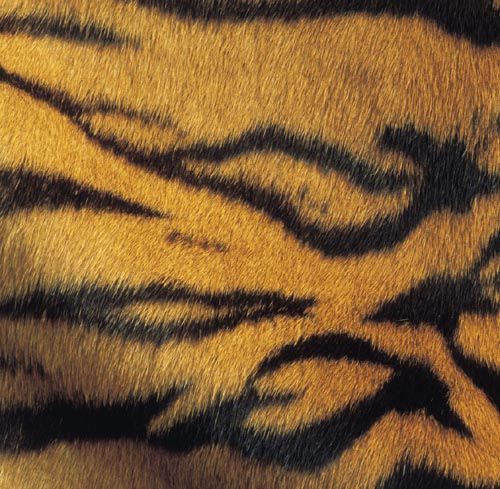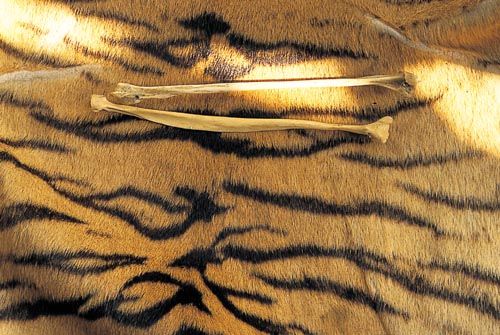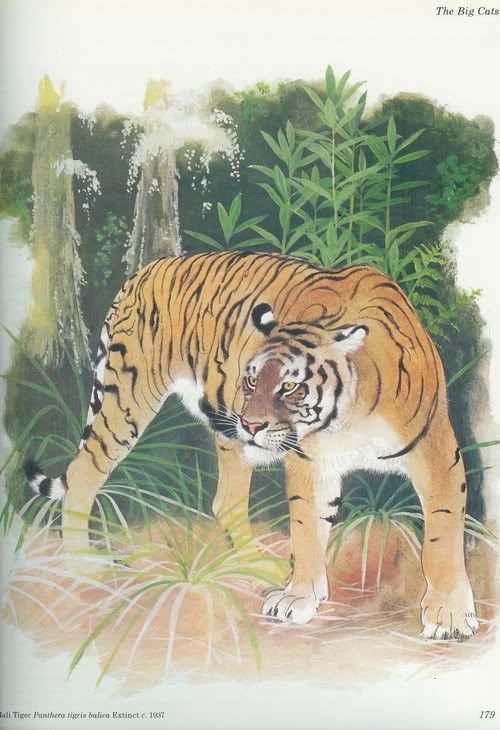|
|
Post by Melanie on May 20, 2005 11:24:53 GMT
|
|
|
|
Post by another specialist on May 20, 2005 12:21:14 GMT
|
|
|
|
Post by Melanie on May 23, 2005 18:38:21 GMT
another painting in the Doomsday Book of Animals
|
|
|
|
Post by another specialist on May 23, 2005 21:01:22 GMT
Good book but a bit out of date now. Got a copy myself when it first came out...
|
|
|
|
Post by another specialist on May 31, 2005 20:03:53 GMT
Most of the eight Bali tiger specimens entered the world's museums in the 1930s; tigers probably disappeared from the island by the end of World War II
|
|
|
|
Post by Peter on Jun 1, 2005 10:54:55 GMT
Here the information on this extinct tiger subspecies from: www.naturalis.nl/300pearls/. It is the specimen of the National Museum of Natural History 'Naturalis' in Leiden, the Netherlands. Bali TigerThe hunting-party animal The Bali Tiger, Panthera tigris balica( Schwarz, 1912) was the eastern-most and smallest sub-species of Tiger. The Tiger population on Bali became isolated from that on Java after the last Ice Age, when the two islands were separated by the Bali Strait. Apart from its small size, the Bali Tiger is very similar to the Javan subspecies, perhaps a shade darker, with the same dense pattern of stripes. Small as the island is, the Tiger population on Bali must always have been quite low. Human population increase, together with agricultural development and deforestation, has led to the disappearance and fragmentation of Tiger habitat. At the beginning of the 20th century, Tigers probably survived only in the mountainous and relatively sparsely populated western part of the island. Here, hunting pressure increased as the country was gradually opened up and many Europeans living in Java organized hunting trips to Bali.  Bali Tiger Photograph by Rosamond Purcell from Swift as a Shadow. © 1999. Rumours The last Tiger stronghold was the north-western tip of the island. The last well-documented specimen was killed there on 20 September 1937, but there are reliable reports stating that Tigers still lived in the area in about 1940 and probably into the early fifties. Due to the Second World War and the following political developments in Indonesia, exact data on the Bali Tiger from the fourties and fifties are lacking, and the time of extinction is not known. Rumours of the survival of Bali Tigers into more recent years are not substantiated. The remaining suitable Tiger habitat in Bali appears to be too small for maintaining a viable population.  Bali Tiger Photograph by Rosamond Purcell from Swift as a Shadow. © 1999. The museum collection The specimen in the National Museum of Natural History comprises a skin, skull and some bones. It was obtained in 1977. The skin had been used as a rug, so it is fairly worn and faded. The animal, a young adult, was probably killed at the end of 1933 by a Dutch medical doctor living on Java. It is one of the eight Bali Tigers - eight skulls and five skins - preserved in scientific collections. ---------------------------------------------------------------------- Dr. L.W. van den Hoek Ostende |
|
|
|
Post by Peter on Jun 1, 2005 10:57:44 GMT
And here the skull from the Hungarian Natural Museum, again from: www.naturalis.nl/300pearls/. The Skull of the Bali TigerPanthera tigris balica (Schwartz, 1912) Inter arma silent musae (the Muses are silent among arms). During great wars little attention is paid to the arts and even less to the environment, and to nature conservation. The fate of the Bali Tiger, Panthera tigris balica ( Schwartz, 1912), is just one of the numerous sad examples. By the end of World War Two, one of the tiger subspecies, extraordinary in several ways, became irrevocably extinct. Of the 8 subspecies generally accepted by researchers, the one living on the island of Bali had the smallest populated territory, which itself is an endangering factor. As far as we know, its habitat was restricted to the shoreline region of the western part of the island. For years, its hunting had been unrestricted by law and finally there was no room left for it on the island becoming ever more densely populated. This was the first of the tiger subspecies to become extinct. Unfortunately, since then, further two subspecies (the Caspian Tiger and the Javanese Tiger) have come to share the same fate.  Skull of the Bali Tiger. Characteristics of the Bali Tiger The Bali Tiger was the smallest bodied tiger. Its weight did not exceed 100 kg, even in case of larger males. Similarly to other tigers, living on the Sunda Islands, its fur was densely striped, but the stripes were wide and often branched, with occasional small black dots between the stripes. The characters of its nasal bone and teeth also distinguished it from the forms living in close geographic proximity.  Oscar Vojnich and his trophy. Rarities even in museums Just as it can never have been in abundance in its original habitat, it is likewise scarce in the museums throughout the world. The remnants of altogether 9 specimens have been preserved. One of these skulls can be found in the Hungarian Natural History Museum. This specimen was killed November 3, 1911, but contrary to numerous old exhibits, much more is known about the history of its acquisition. The collector, Baron Oscar Vojnich, in his book entitled " On the East Indian Group of Islands" describes the hunt in detail: "In the western part of Bali Island, along the northern shore, in the mountains of Goendoel, we discovered tiger footprints... On November 2nd, while collecting twigs to be used for constructing a fence around the traps, the carcass of a freshly killed kidang (a roe-like animal) was encountered by the people. The trap was set in front of the kidang, in the thicket. Munaut was almost certain that the tiger would be caught in another day. I was much less convinced, as the many human tracks could have warned the tiger. But no, it came to feed on the slightly smelly joint, and the trap caught one of its forelegs, just below the wrist." -------------------------------------------------------------------------------- Csorba, Gábor |
|
|
|
Post by RSN on Nov 19, 2005 23:15:32 GMT
These colored photography above the black and white are coloured in computer, right?
|
|
|
|
Post by another specialist on Nov 19, 2005 23:28:58 GMT
Yes this photos have been edited remember this photos are pre 1950's
|
|
|
|
Post by Bowhead Whale on Nov 23, 2005 20:31:16 GMT
So, as I can see, the stripes of the balinese tiger were wider than the sumatran or the bengal. Alright. By the way, I'm truly sorry to say that, but isn't a shame Eric Alibair (the one who draw the image Moderator brought) shows such poor anatomic notions in his works? This tiger has its feet turned on the inside! And it's not the worst I saw... It's a shame, because when it comes to represent furry, scaly or feather textures, he's a champion. But when it comes to copy the inside structure of muscles and bones... I'd better shut up.
|
|
|
|
Post by another specialist on Nov 24, 2005 7:52:59 GMT
This the anatomic notions in this work are pretty poor when you look it for carefully like you said about the feet positioning its all wrong really.
|
|
|
|
Post by sebbe67 on Jan 22, 2006 15:23:22 GMT
|
|
|
|
Post by another specialist on Jan 23, 2006 11:29:05 GMT
|
|
peej2
Full Member
  
Posts: 118
|
Post by peej2 on Mar 5, 2006 18:01:56 GMT
Does someone have more inormation on Oscar Vojnich and the story of his tiger. I've heard bits and peaces but does anybody have the full story of the hunt. Or perhaps some photographs of the perserved museum specimens.
|
|
|
|
Post by another specialist on Mar 5, 2006 18:10:31 GMT
Does someone have more inormation on Oscar Vojnich and the story of his tiger. I've heard bits and peaces but does anybody have the full story of the hunt. Or perhaps some photographs of the perserved museum specimens. If you go through this thread and click the links you'll find photos of skulls, skins and photos of hunts. |
|
peej2
Full Member
  
Posts: 118
|
Post by peej2 on Mar 19, 2006 22:17:54 GMT
Isn't there an image of this tiger subspecies in the doomsday book of animals? Or is that a different tiger on the cover of the book??
|
|
|
|
Post by Melanie on Mar 20, 2006 8:57:13 GMT
Yes there is a painting of a Balinese Tiger on the cover of that book. Isn't there an image of this tiger subspecies in the doomsday book of animals? Or is that a different tiger on the cover of the book?? |
|
|
|
Post by another specialist on Mar 20, 2006 10:29:14 GMT
 here is that pic peej2 |
|
peej2
Full Member
  
Posts: 118
|
Post by peej2 on Mar 20, 2006 13:59:19 GMT
Thank you. I have seen this in another tiger book from the library where I'm from, but I didn't know what kind of tiger it was...until I saw it on the cover of the Doomsday Book of Animals. Is there an image of the Javan tiger or Caspian in this book? If not, then why not?
|
|
|
|
Post by Melanie on Mar 20, 2006 14:42:34 GMT
There are no paintings of the Javan and Caspian Tiger because as far as i know they were declared officially extinct in the middle of the 1980s and this was after the publishing of the book (1981).
|
|